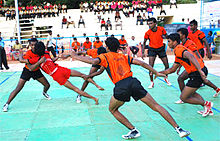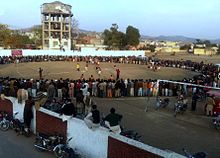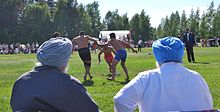| Revision as of 21:07, 24 October 2016 editAriradha (talk | contribs)87 edits Kabaddi originated in Tamil nadu← Previous edit | Revision as of 21:08, 24 October 2016 edit undoAriradha (talk | contribs)87 editsNo edit summaryNext edit → | ||
| Line 4: | Line 4: | ||
| ] | ] | ||
| '''Kabaddi''' is a ] that originated from ], southern state of ]. It is also known as ''sadu-gudu''. ] is great place where ] was also originated. The term kabaddi covers a number of related games including ''hadudu'' in ], ''bhavatik'' in ], ''kauddi'' in the ], ''chedugudu'' in ], ''sadugudu'', ''pathanjikodu'' and ''kaipidi'' in ]'', and ''kabalisu''(ಕಬಳಿಸು) meaning "to gulp" in ].<ref>{{cite web|url=https://cultural.maharashtra.gov.in/english/gazetteer/Poona/PART%20III/Chap%20(3)/Games.htm|title=Games in Maharashtra|publisher=Government of Maharashtra|access-date=17 July 2015}}</ref><ref>{{Cite web|url=http://asiankabaddi.org/history.php|title=History of Kabaddi - Asian Amateur Kabaddi Federation|website=asiankabaddi.org|access-date=2016-10-19}}</ref>'' | '''Kabaddi''' is a ] that originated from ], southern state of ]. It is also known as ''sadu-gudu''. ] is great place where ] was also originated. The term kabaddi covers a number of related games including ''hadudu'' in ], ''bhavatik'' in ], ''kauddi'' in the ], ''chedugudu'' in ], ''sadugudu'', ''pathanjikodu'' and ''kaipidi'' in ]'', and ''kabalisu''(ಕಬಳಿಸು) meaning "to gulp" in ].<ref>{{cite web|url=https://cultural.maharashtra.gov.in/english/gazetteer/Poona/PART%20III/Chap%20(3)/Games.htm|title=Games in Maharashtra|publisher=Government of Maharashtra|access-date=17 July 2015}}</ref><ref>{{Cite web|url=http://asiankabaddi.org/history.php|title=History of Kabaddi - Asian Amateur Kabaddi Federation|website=asiankabaddi.org|access-date=2016-10-19}}</ref>'' | ||
| ==Etymology== | ==Etymology== | ||
Revision as of 21:08, 24 October 2016
For other uses, see Kabadi (disambiguation).

Kabaddi is a contact sport that originated from Tamil Nadu, southern state of India. It is also known as sadu-gudu. Tamil Nadu is great place where Jallikattu was also originated. The term kabaddi covers a number of related games including hadudu in Bengal, bhavatik in Maldives, kauddi in the Punjab region, chedugudu in Andhra Pradesh, sadugudu, pathanjikodu and kaipidi in Tamil Nadu, and kabalisu(ಕಬಳಿಸು) meaning "to gulp" in kannada.
Etymology
The word "Kabbadi" is derived from the Tamil word "kai-pidi"(கைபிடி) meaning "to hold hands". It is also known as sadu-gudu.
History

Kabaddi is an ancient game played in many states across India using local rules. Generally, raiders are considered as bulls who play against the defenders. The essence of the game is the holding of the raiders by the defenders. Some forms of the game originated in south India whilst other forms of kabaddi originated in northern parts of India. Though variations emerged and rules were framed, the game’s principal objective remained unchanged.
Modern Kabaddi is therefore a synthesis of the game played in various forms under different names. Kabaddi received international exposure during the 1936 Berlin Olympics, demonstrated by India. The game was introduced in the Indian National Games at Calcutta in 1938. In 1950 the All India Kabaddi Federation (AIKF) came into existence and framed the rules. The AIKF was reconstituted as The Amateur Kabaddi Federation of India (AKFI) in 1972 and the first national tournament for men was held in Chennai.
Kabaddi was introduced to and popularised in Japan in 1979 by Sundar Ram of India, who toured Japan on behalf of Asian Amateur Kabaddi Federation for two months to introduce the game. In 1979, matches between Bangladesh and India were held across India. The first Asian Kabaddi Championship was held in 1980 and India emerged as champion, beating Bangladesh in the final. The other teams in the tournament were Nepal, Malaysia, and Japan. The game was included for the first time in the Asian Games in Beijing in 1990 where seven teams took part.
This game is also known as 'Ha-doo-doo' in Bangladesh.
Variations
International

| External videos | |
|---|---|
In the international team version of kabaddi, two teams of seven members each occupy opposite halves of a field of 10 by 13 metres (33 ft × 43 ft) in case of men and 8 by 12 metres (26 ft × 39 ft) in case of women. Each has three supplementary players held in reserve. The game is played with 20-minute halves and a five-minute halftime break during which the teams exchange sides.
The teams take turns sending a "raider" into the other half. To win a point, the raider must take a breath, run into the opposing half, tag one or more members of the opposite team, then return to their home half before inhaling again. The raider will chant "kabaddi, kabaddi" with their exhaling breath to show the referee they have not inhaled. The raider will be declared "out" and will not gain the point if they inhale before returning to their side, or returns without touching an opponent. The tagged defender(s) will be "out" if they do not succeed in catching the raider who tagged them. Wrestling the raider to the ground can prevent them escaping before they need to inhale.
Defenders may not cross the centre line (the "lobby") of the field and the raider may not cross the boundary lines. However, there is one bonus line which can grant extra points for the raider if he manages to touch it and return successfully. Players who are out are temporarily sent off the field. Each time a player is out, the opposing team earns a point. A team scores a bonus of two points (called a "lona"), if the entire opposing team is declared out. At the end of the game, the team with the most points wins. Matches are categorised based on age and weight. Six officials supervise a match: one referee, two umpires, a scorer and two assistant scorers.
Indian

There are four major forms of kabaddi played in India which are recognised by the amateur federation. In Sanjeevani Kabaddi, one player is revived against one player of the opposite team who is out – one out. The game is played over 40 minutes with a five-minute break between halves. There are seven players on each side and the team that outs all the players on the opponent's side scores four extra points. In Gaminee style, seven players play on either side and a player put out has to remain out until all his team members are out. The team that is successful in ousting all the players of the opponent's side secures a point. The game continues until five or seven such points are secured and has no fixed time duration. Amar style resembles the Sanjeevani form in the time frame rule. But, a player who is declared out doesn’t leave the court, but instead stays inside, and the play goes along. For every player of the opposition touched ‘out,’ a team earns a point. Punjabi Kabaddi is a variation that is played on a circular pitch of a diameter of 22 metres (72 ft).
Notable competitions
Asian Games

Kabaddi has been played at the Asian Games since 1990. The Indian team has won all seven Gold medals. The next most successful team is Bangladesh, which has won three silver medals.
Asia Kabaddi Cup
The Asia Kabaddi Cup has been held twice in consecutive years. The inaugural tournament was held in 2011 in Iran. In 2012, the Asia Kabaddi Cup was held in Lahore (Pakistan) from 1 to 5 November. In the 2012 ASIA Kabaddi Cup, Pakistan won against India with a technical win after Indian team forfeited the match following a dispute.
Kabaddi World Cup
Kabaddi World Cup was first played in 2004, then in 2007 and then annually from 2010 onwards. A circle format is followed from 2010 World Cup onwards. India is the unbeaten champion winning every edition held so far. The 2016 Kabaddi World Cup contested from 7 to 22 October 2016 in Ahmedabad, India, with twelve countries competing in the tournament was won by team India under the captaincy of Anup Kumar. India defeated Iran with score 38-29 in final match. India is by far the most successful international Kabaddi team in the world. Bangladesh won three bronzes in Kabddi.
Women's World Cup
The first Women's Kabaddi World Cup was held in Patna, India in 2012. India won the championship, defeating Iran in the finals. India retained the title in 2013, defeating debutants New Zealand in the finals.
Pro Kabaddi League
Main article: Pro Kabaddi LeagueThe Pro Kabaddi League was established in 2014; the league modeled its business upon that of the Indian Premier League of Twenty20 cricket, with a large focus on marketing, the backing of local broadcaster Star Sports, and changes to the sport's rules and its presentation to make it more suitable for a television audience. The PKL quickly became a ratings success on Indian television; the 2014 season was watched by at least 435 million over the course of the season, and the inaugural championship match was seen by 86.4 million viewers.
UK Kabaddi Cup

Kabaddi received major recognition in the United Kingdom during the 2013 UK Kabaddi Cup. It featured the national kabaddi teams from India, England, Pakistan, the United States, Canada, and a local club team sponsored by SGPC. The UK Kabaddi Cup hosts the Punjab circle style of kabaddi.
World Kabaddi League
World Kabaddi League was formed in 2014. The league includes eight teams from four countries – Canada, England, Pakistan, and the United States – and plays the Punjabi circle style of kabaddi. Some of the teams are owned or part owned by actors – Akshay Kumar (Khalsa Warriors), Rajat Bedi (Punjab Thunder), Sonakshi Sinha (United Singhs) and Yo Yo Honey Singh (Yo Yo Tigers). The inaugural league season was played from August 2014 to December 2014. United Singhs (Birmingham, England) won the finals defeating Khalsa Warriors (London, England) in the first season.
Popularity
Kabaddi is a popular sport in South Asia. The Kabaddi Federation of India (KFI) was founded in 1950, and it compiled a standard set of rules. The governing body for kabaddi in Pakistan is Pakistan Kabaddi Federation. In Bangladesh, a variation of kabaddi called Ha-Du-Du is popular. Ha-Du-Du has no definite rules and is played with different rules in different areas. Kabaddi is the National Game of Bangladesh and the Amateur Kabaddi Federation of Bangladesh was formed in 1973. In Iran, the Community of Kabaddi was formed in 1996, in same year they joined the Asian Kabaddi Federation and in 2001 they joined the International Kabaddi Federation. The Iran Amateur Kabaddi Federation was formed in 2004.
Kabaddi is one of the national sports of Nepal. Kabaddi is played and taught at a very early age in most primary schools beginning in the third grade or so in most Nepali schools. Kabaddi was also played by the British Army for fun, to keep fit and as an enticement to recruit soldiers from the British Asian community. Kabaddi was brought to the United Kingdom by Indian immigrants and Pakistani immigrants. The governing body for kabaddi in the United Kingdom is the England Kabaddi Federation UK.
In popular culture
- Films depicting kabaddi
- Kudumba Thalaivan (1962 )
- Little Buddha (1993)
- Pardes (1997)
- Hu Tu Tu (1999)
- Kabaddi Kabaddi (2003)
- Okkadu (2003)
- Ghilli (2004)
- Ajay (2006)
- Kabaddi (2009)
- Vennila Kabadi Kuzhu (2009)
- Bheemli Kabadi Jattu (2010)
- Chal Dhar Pakad (2010)
- Kabaddi Once Again (2012)
- Badlapur Boys (2014)
- Tevar (2015)
- Thoppil Joppan (2016)
- Anime depicting kabaddi
- Full Metal Panic? Fumoffu (2003)
- Gintama (2006)
- Teekyu (2013)
- Durarara!!×2 Shō (2015)
- Chio-chan no Tsuugakuro (2016)
References
- "Games in Maharashtra". Government of Maharashtra. Retrieved 17 July 2015.
- "History of Kabaddi - Asian Amateur Kabaddi Federation". asiankabaddi.org. Retrieved 19 October 2016.
- "kabaddi, etymology".
- "Kabaddi, definition".
- "Pro Kabaddi league returns". Live Mint. Retrieved 2 August 2015.
- "Kabaddi doping hits world". The Telegraph. London. Retrieved 2 August 2015.
- "Sporting events add fun to festivities". indiannewslink. Retrieved 2 August 2015.
- India: A Travel Survival Kit. Lonely Planet Publications. 2005.
- Hasan, Amir (1978). The folklore of Buxar. Academic Press.
- Anjaria, Ulka Shapiro (2007). Novel forms: literary realism and imaginations of modernity in India, 1930-1940. Stanford University.
- Mills, James H. (2005). Subaltern Sports: Politics and Sport in South Asia. Anthem Press. pp. 50–. ISBN 978-1-84331-167-6.
- Dyck, Noel (2000). Games, Sports and Cultures. Bloomsbury Academic. ISBN 978-1-85973-312-7.
- Williams, Victoria (2015). Weird Sports and Wacky Games around the World: From Buzkashi to Zorbing. ABC-CLIO. pp. 151–. ISBN 978-1-61069-640-1.
- Chakraborty, Subhas Ranjan; Chakrabarti, Shantanu; Chatterjee, Kingshuk (2013). The Politics of Sport in South Asia. Routledge. pp. 19–. ISBN 978-1-317-99837-2.
- "kabaddi | sport". Encyclopedia Britannica. 22 September 2014. Retrieved 17 March 2015.
- ^ "Welcome to International Kabaddi Federation". Kabaddiikf.com. 30 April 2010. Retrieved 17 March 2015.
- "History of Kabaddi". Amateur Kabaddi Federation of India. Retrieved 31 July 2015.
- "Kot Kalan". Shaheed Bhagat Singh Memorial Sports Club. 11 April 2010. Retrieved 20 May 2015.
- "Rules of Kabaddi". International Kabaddi Federation (IKF). Retrieved 26 August 2014.
- "Kabaddi In India: Origins, success and current pitiable state". Sportskeeda.com. 7 March 2014. Retrieved 17 March 2015.
- Kissa 2 Kabaddi da. Sarwan Singh Sangam Publications. ISBN 93-83654-65-1.
- "Not so easy way forward for kabaddi". Tribune India. 22 December 2014. Retrieved 17 March 2015.
- Praveen. "Indian Men & Women Won Kabaddi World Cup 2014". Affairscloud.com. Retrieved 17 March 2015.
- "India win first women's Kabaddi World Cup". Hindustan Times. 4 March 2012. Retrieved 4 April 2012.
- "Kabaddi gets the IPL treatment". BBC News. Retrieved 22 October 2016.
- "Pro Kabaddi league viewership second only to IPL". The Hindu. Retrieved 22 October 2016.
- "Simple, visceral, fun: why the ancient sport of kabaddi is enjoying a resurgence". The Guardian. Retrieved 21 October 2016.
- Ripley, Dan (6 August 2014). "Kabaddi was once a Trans World Sport favourite but now it's heading for the 02 Arena as WKL forms". Daily Mail. Retrieved 16 August 2014.
- ^ "World Kabaddi League announces team franchise names and logos". IBNLive. 24 July 2014. Retrieved 17 March 2013.
- "Home - The official website of World Kabaddi League". Worldkabaddileague.net. 9 August 2014. Retrieved 16 August 2014.
- "United Singhs crowned World Kabaddi League champions". IBNLive. 22 November 2014. Retrieved 17 March 2013.
- "Honey Singh's kabaddi team Yo Yo Tigers suspended". Hindustan Times. 15 November 2014. Retrieved 17 March 2013.
External links
- International Kabaddi Federation official website
- Asian Amateur Kabaddi Federation official website
- Amateur Kabaddi Federation of India (AKFI) official website
- A Game Called Kabbadi – slideshow by The New York Times
| International kabaddi | |||||||
|---|---|---|---|---|---|---|---|
| International Kabaddi Federation (2004–present) · World Kabaddi (2018–present) · World Kabaddi League (2014) · World Kabaddi Federation | |||||||
| National teams | |||||||
| International tournaments |
| ||||||
| Multi-sport events |
| ||||||
| Domestic tournaments |
| ||||||
| Team sports | |||||||||||||||||||||||||||||||||||||||||||
|---|---|---|---|---|---|---|---|---|---|---|---|---|---|---|---|---|---|---|---|---|---|---|---|---|---|---|---|---|---|---|---|---|---|---|---|---|---|---|---|---|---|---|---|
| Ball sports |
| ||||||||||||||||||||||||||||||||||||||||||
| Tag sports | |||||||||||||||||||||||||||||||||||||||||||
| Water sports | |||||||||||||||||||||||||||||||||||||||||||
| Other non-ball sports | |||||||||||||||||||||||||||||||||||||||||||
| Main symbols |
| |
|---|---|---|
| Monuments and Memorials |
| |
| People |
| |
| Flora and fauna |
| |
| Other symbols |
| |

